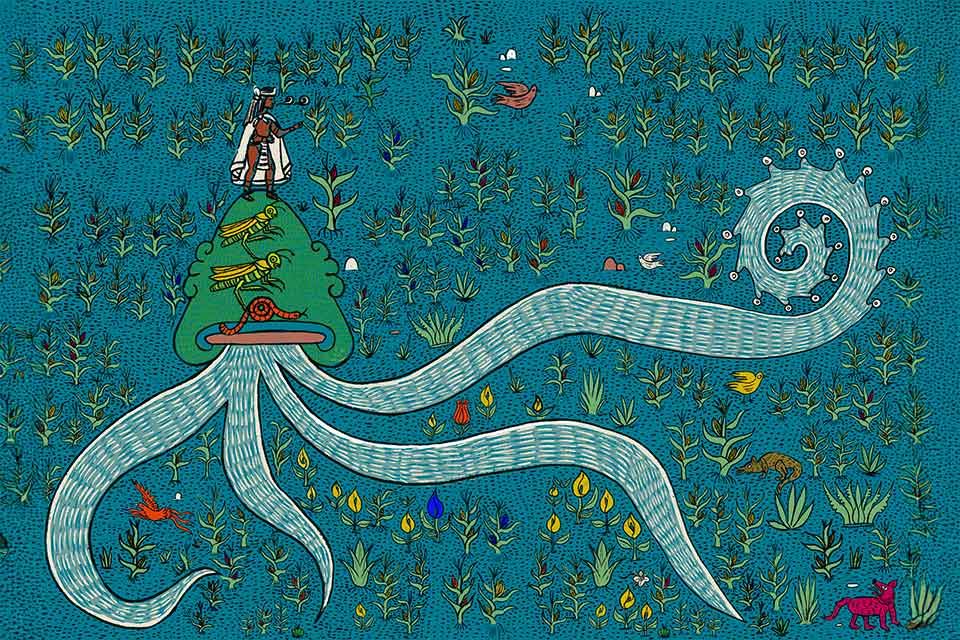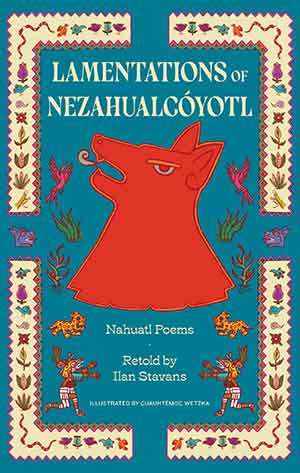Responding to Nezahualcóyotl: A Dialog with Ilan Stavans, by Susan Nash

Lamentations of Nezahualcóyotl: Nahuatl Poems (Stressed Books, 2025), by Ilan Stavans, is a set of poems that seize, from authentic Nahuatl songs, the voice of Aztec warrior, king, poet, and thinker Nezahualcóyotl, who lived half a century earlier than the arrival of the Spanish. The next is a dialog with Stavans concerning the inspiration for his work, the texts he consulted, and his influences as he sought to search out new methods for audiences to attach with Nezahualcóyotl.
Susan Smith Nash: I actually appreciated the truth that, as you identified that over time, Nezahualcóyotl has achieved nearly legendary standing (on the very least, legendary) as a warrior-poet, thinker, and, above all, king who foretold the approaching arrival of the Europeans and the nice struggling to return. As a form of apocalyptic prophet, how a lot did the apocalyptic narrative form your understanding of him? When you intentionally strip out the apocalyptic narrative, how does your notion of his work and his concepts change?
 Ilan Stavans: Nezahualcóyotl, in my opinion, was a form of prophet. One of many distinctions of prophesy is its apocalyptic nature. He died fifty years earlier than the arrival of the Spaniards, but in my eyes he foresaw the cataclysm that awaited his individuals. After all, my Nezahualcóyotl is as a lot a creation as is the one in all earlier generations. Therein, I imagine, lies the character of historic figures: it isn’t a lot who they had been however who we would like them to be.
Ilan Stavans: Nezahualcóyotl, in my opinion, was a form of prophet. One of many distinctions of prophesy is its apocalyptic nature. He died fifty years earlier than the arrival of the Spaniards, but in my eyes he foresaw the cataclysm that awaited his individuals. After all, my Nezahualcóyotl is as a lot a creation as is the one in all earlier generations. Therein, I imagine, lies the character of historic figures: it isn’t a lot who they had been however who we would like them to be.
Nash: His themes, ideas, and historic references take the reader to a different world, and I respect the readerly journey. The place did you discover the supply paperwork? Are they in codices? Had been they translated into Spanish? A lot is talked about in your foreword. Was it arduous to search out the originals?
Stavans: Rising up in Mexico within the Seventies, Nezahualcóyotl was an icon with a profound affect. A semi-autonomous “subcity,” adjoining to Mexico Metropolis, popularly referred to as Ciudad Nezahualcóyotl (abbreviated as Neza), turning into an unbiased municipality in 1963, was named after him. With an estimated inhabitants of over a million at the moment, Neza sits over what as soon as was Lake Texcoco, one of many 5 linked lakes over which Tenochtitlán, the capital of the Aztec Empire, was constructed. Neza was a slum, however it’s now an astonishing place the place one witnesses the capability of Mexicans for self-reliance.
I keep in mind studying at school that Nezahualcóyotl was a forward-looking chief in addition to a poet, a thinker, a warrior, and an city planner. However a lot of the work concerning the Mexica previous is conveyed to us by Franciscan monks like Fray Bernardino de Sahagún and Alonso de Molina, in locations like Colegio de Santa Cruz de Tlatelolco and different Spanish-language facilities of studying throughout colonial occasions. The poems of Nezahualcóyotl are compiled in nearly 100 Nahuatl songs referred to as Cantares Mexicanos. I first learn it within the Spanish translations by Ángel María Garibay and subsequently accessed the Nahuatl variations.
You will need to be cautious concerning the poems for a few causes: first, just like the biblical King Solomon, for example, the poetry attributed to him was possible written by scribes inside his courtroom in Texcoco however attributed to him; and second, the transcriptions in Nahuatl and Spanish had been produced within the sixteenth century, lengthy after Nezahualcóyotl died in 1472. In different phrases, what we now have are echoes of the poet.
What we now have are echoes of the poet.
Nash: Are all of the poems written in Nahuatl, and did the poems seem as they do within the assortment, or did you’re taking blocks and chunks and create the “retelling”? What was the method, and the way did you make the choices that you just made?
Stavans: In 1985 John Bierhorst, who as soon as edited an anthology of Latin American folktales, did a scholarly translation of Cantares Mexicanos. He known as it Songs of the Aztecs. It wasn’t a poetic translation however an archaeological one. Studying him and Garibay, and exploring the códices the place Nezahualcóyotl makes an look, I felt he was calling me, asking to be introduced again to life, rescuing the determine of my childhood that has gained in measurement and affect as I’ve grown older. To be able to accomplish that, I set myself the duty of studying as a lot as I might about Nezahualcóyotl’s time: his language, his tradition, his legacy.
Nash: There are various poems that describe the motion of self-reification, and the situations that lead as much as the necessity to reinvent oneself. What are a few of the alternative ways, and precipitating elements, that make Nezahualcóyotl form the notion of self-creation?
Stavans: He isn’t an harmless chief—no chief ever is. In truth, he isn’t solely narcissistic however transactional: since he is aware of he can be remembered, he needs to control that legacy to the perfect of his potential. Nonetheless, fame is all the time a betrayal.
Nash: There are various references to the ability of language—they appear nearly Wittgensteinian at occasions (“the bounds of language are the bounds of my world”), and on the identical time, there’s a present of animism and shape-shifting. I’m reminded of the Mayan poets who use language as invocations, to animate inanimate objects. This might contribute to the environment of “lo actual maravilloso,” however much more powerfully, it appears to mirror again to Indigenous Mexican beliefs and the way they’re constructed into the language in order that prayers and invocations lead to casting spells to harness the spirits in every thing round one to assist with life. What are your ideas about that? How did you meld Indigenous methods of viewing language along with your translation?
Nahuatl should have been like Sumerian on the time of Gilgamesh, Latin within the Center Ages, French in the course of the Enlightenment, and English in our age of besieged globalism.
Stavans: I’m weary of the best way the Indigenous previous is romanticized. The Mexicas—the time period “Aztec” wasn’t utilized by them—had been as manipulative and self-interested as we’re at the moment. What intrigues me, although, is their language. How did they use it? Or higher, how did they abuse it? Nahuatl was the lingua franca in Tenochtitlán, a impartial tongue that allowed retailers, warriors, monks, slaves, and others from a wide range of backgrounds to work together with one another. Students imagine that when Hernán Cortés conquered town, there have been sixty-eight languages spoken within the area. Nahuatl should have been like Sumerian on the time of Gilgamesh, Latin within the Center Ages, French in the course of the Enlightenment, and English in our age of besieged globalism.
As for magical realism, to me Nezahualcóyotl’s voice is a forerunner to Jorge Luis Borges, Alejo Carpentier, and Gabriel García Márquez. His imagery intertwines the true with the dreamlike, although not in a cutesy approach. He interrogates what’s genuine and what’s imagined, typically concluding that the skinny line separating the 2 is itself fictional. He’s like Cortázar’s axolotl. But I additionally acknowledge in him numerous different echoes. Briefly, Nezahualcóyotl for me is a common poet whose work paves the best way—anachronistically—to Rumi, Shakespeare, Quevedo, John Keats, Cavafy, Pablo Neruda, and Seamus Heaney. Why not? In poetry, none of us is imprisoned within the current.
Nash: There are a number of passages that confer with punishment—and punishment for various offenses and sorts of individuals. In some ways, it’s a approach of figuring out the “Different”—however for what? For instance, is it for punishment? Or, for opening the door to at the very least admitting the concepts of the Different?
Stavans: There isn’t any civilization that isn’t advanced. The Mexica world, like ours, was obsessive about guidelines: how one can placate the ire of the gods, who ought to stay and who ought to die, what’s a worthy life, the chaos of nature, and so forth. There was a strict authorized code that condemned alcoholism, pederasty, and different deviations from the norm. Of their catechism, the Spaniards known as this conduct sinful. The Mexican didn’t imagine in sin, which doesn’t imply they didn’t have an idea for abhorrence.
Nash: There are such a lot of totally different ideas—so profound! I’ve made an inventory of at the very least a dozen, and I’d like to discover them. Some embody the ambiguous nature of actuality, the ephemeral nature of our personal lives, the silly quest to personal the earth (which belongs to nobody), the best way we set ourselves as much as be conquered by first vanquishing ourselves by self-destructive conduct . . . and these are only a few.
Stavans: The Spanish believed the Mexica to be barbaric, simply because the Mexica noticed their sudden guests from the ocean as barbaric. It was a colossal conflict of cultures. The Spanish killed tens of millions, but at the moment they carry the burden of these atrocities. In reality, there are not any winners and losers in historical past. Issues all the time seem to occur simply now, sure, proper now. However the current is a mirror: malleable, evanescent, and fragile. There are numerous methods to interpret it.
The current is a mirror: malleable, evanescent, and fragile. There are numerous methods to interpret it.
Nash: After working with so many texts and immersing your self in time-travel (somewhat than “historical past,” as a result of what you’ve gotten completed has the depth of an immersion), and a union with the texts and the concept of the individual, what are the highest 4 or 5 ideas that constantly rise to the highest?
Stavans: I’m an immigrant from Mexico to the US. And I’m from a household that got here from Poland, Belarus, and Ukraine to Mexico. My life has been about movement. But it’s the roots of my childhood that floor me. I typically see Nezahualcóyotl showing earlier than me at night time: vigorous, emblematic, resonant in his silence. We’re all what others make of us. By means of this immersion, I’ve used the languages that had been granted to me, the languages at my disposal, to pay the large debt I owe to Mexico.

0 Comment